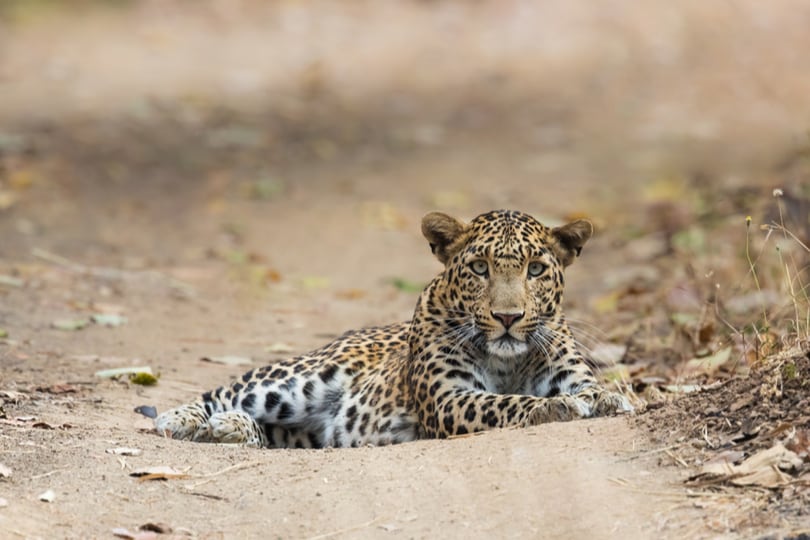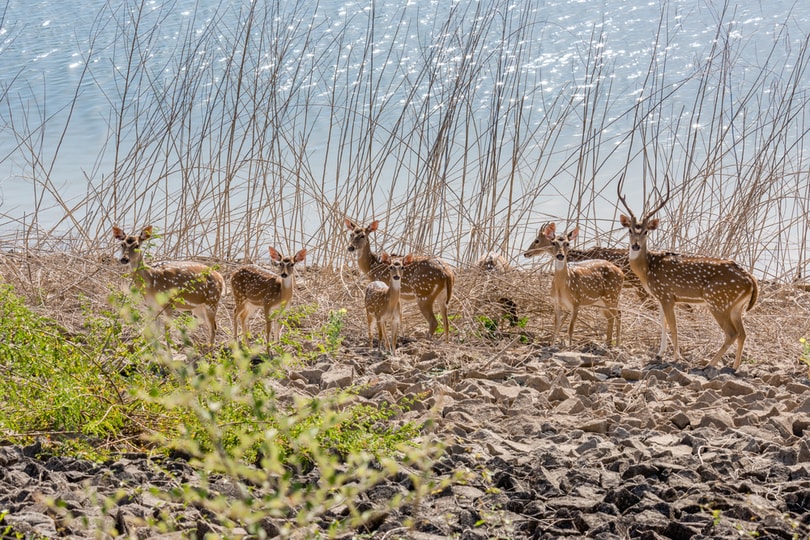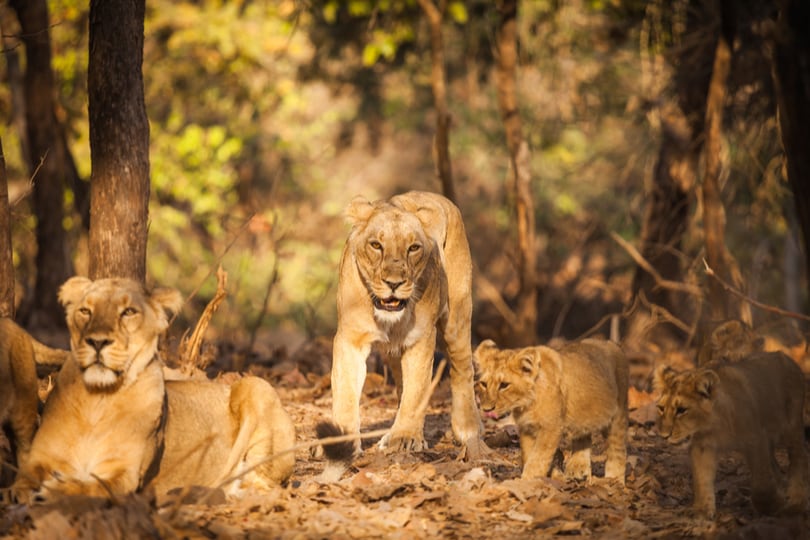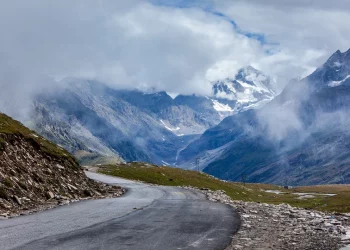Exploring the Stories of the Forest in Gir National Park
Imagine a sultry afternoon amidst forests of deciduous trees, far from the madding crowd. The only sounds are the gentle purr of the vehicle you’re in, the song of wild birds, the quick swish of a crocodile’s tail in the marshy waters or alarm calls from a herd of deer. Not a soul stirs in this expansive forest, but you’re acutely aware you’re not alone. And even though you might have seen nothing yet, you sense abundant life and mystery all around you. You’re in the home of the big cat and one of the only places in the world where they can still be found roaming wild and free. Welcome to the home of the last surviving Asiatic lions. Welcome to the splendid Gir National Park in Gujarat!
If an African safari is the stuff of dreams for you, Gir National Park is closer to home and equally stunning. One can only imagine a time when these forests covered more extensive areas, and wild lions outnumbered humans. While the star of the forest is the Asiatic Lion, Gir National Park is best experienced by understanding all the stories of the forests – From its majestic lions to elusive leopards, or the laugh of the hyenas. Spotting wildlife requires patience and respect for the wild. You already know this if you’re a wildlife enthusiast and don’t mind long waits sometimes lasting days. Three to four days with a knowledgeable guide is ideal for a great wildlife experience in Gir.
There’s nothing like a few days in the wild to shatter our illusions of power and security. It’s a glimpse into how life used to be and how vulnerable we are outside our bubbles. It’s also a reminder of what a beautiful and mesmerizing world we inhabit. And the importance of making concerted efforts to understand and preserve this magnificent yet fragile natural world.
Going Back

Until the early 19th century, Asiatic lions could be found all across South and Southwest Asia. But the rise in the human population took over large parts of the lion’s habitat. The destruction of their natural habitat was only the beginning of the end. The manufacturing of guns and subsequent hunting for sport meant that nearly all the lions remaining outside Gujarat were hunted and killed from 1800-1860. Within Gujarat, indiscriminate hunting by the people of Junagarh led to a drastic decrease in population, even as they were completely wiped out from the other parts of Asia. The last Asiatic lions in India outside of Gir forest were killed in 1886 at Rewah, and the last wild lion sighted outside India was in Iran in 1941.
In 1901, Lord Curzon was on a visit to Junagadh and was offered to be taken lion hunting. He reportedly declined the offer and suggested that the Nawab of Junagadh protect the only lions left in Asia instead of hunting them. In what was probably the first institutional wildlife conservation effort in India, the Nawab began the long and arduous journey towards protecting the species. He started by preserving the lions within his private hunting grounds.
The Department of Forest Officials stepped in later to protect one of the world’s most threatened species. From a population of approximately 20 lions in 1913, the numbers have risen to 523, according to the 2015 census – A mammoth effort made possible by the Nawab’s conservation efforts and the Indian Government’s post-Independence ban on lion killing in 1955.
In the Wilderness of Gir

Hills, Forests, and Grasslands
Drive across rugged hills, densely forested valleys, and vast grasslands. One never knows what magical fauna will poke its head out from the teak forests and evergreen trees! The beautiful Hiran river flows throughout the year, while others make their appearance in different seasons. The park also has areas with open scrub and savannah-type grasslands. This variety of vegetation provides the perfect home for different kinds of animals.
Antelope and Deer

Chital, or Indian spotted deer, inhabits the dry and mixed deciduous forest. With a population of over 32,000, it is the most sighted animal in the Gir National Park. The Sambar, on the other hand, is more reclusive. It is commonly spotted in the western part of the park. The rarely-spotted Chausingha, or the world’s only four-horned antelope, stays hidden but can be found close to a water source. Another gazelle that can be found roaming the forest is the Chinkara, the single gazelle in the world with horns on both males and females.
The Maldharis – At One With the Forest
The local Maldhari community has lived in Gir for generations, coexisting beautifully with the wilderness. The lives of the people from the Maldhari community depend on their livestock and harvesting what they need from the forest. They often lose a large portion of their cattle to lions and other predators, but they harbor no resentment and look at it as Prasad. It is an offering in exchange for living in a home that belongs to other creatures. The Maldhari way of life is the most excellent example of how people have always lived in harmony with nature. And how we can continue doing so by the choices we make every day.
Birds

Gir National Park is home to over 300 species of birds. In the mad rush to spot the lion, visitors end up missing the birding delights that the park has to offer! Many birds here can be spotted throughout the year – from pelicans, crested serpent eagles and vultures to Malabar whistling thrush and Paradise flycatchers.
Reptiles, Monkeys, and Other Mammals

The forests of the Gir National Park are the ideal playground for a host of different animals. Groups of Langurs make their way from treetop to treetop. The fascinating and often misunderstood striped hyenas can be found scavenging their way through the grasslands and scrublands. Wild boars that dig into the ground for tuber provide aeration of the soil.
If you’re an ardent follower of channels like National Geographic or Animal Planet, you might be familiar with the fiercest predator of them all – the honey badger! Rightly dubbed the “most fearless animal” in the Guinness Book of World Records, this seemingly tiny but ferocious animal is known for taking down snakes.
Speaking of reptiles, Gir National Park is home to fascinating creatures such as the common Krait, Russell’s Viper, Indian Rock Python, the Monitor Lizard, and the saw-scaled Viper. If you look closer, you might also spot smaller mammals such as the endangered pangolins, pale hedgehogs, Indian hares, and grey musk shrews. The Kamaleshwar reservoir within the park has the largest population of marsh crocodiles in the country.
Wild Cats
While the famous lions take up most of the spotlight, the park is also home to four other feral cats. The park has around 300 leopards who are nocturnal, and therefore, harder to spot. The smaller jungle cat is spotted often while the elusive desert cat is seldom seen. The rusty-spotted cat has only recently been seen in Gir.
The Asiatic Lion

The majestic Asiatic lion or Sher is the undisputed ruler of the forests in Gir. With a length of over two and a half meters, an average weight of 115 to 200 kg, and the ability to sprint short distances at 65 km/h – the king of the forest is a force to be reckoned! Its preferred prey are Sambar deers, Chital, Nilgai, and Chinkara. A lion will usually make a kill and feast on up to 75 kg of meat in one sitting! It then spends a few days lounging around with a full stomach and not a care in the world. Lions will never attack an animal if they’re not hungry. The lions and lionesses in the park know they rule the roost and act like it too. They are utterly unperturbed by the presence of humans. According to a 2015 census, the number of lions in Gir National Park was a reassuring 523.
How to Reach Gir National Park
Avid wildlife lovers, conservationists, and curious travelers flock to Gir National Park from October to June each year. April and May are very hot but considered to be the best months for wildlife viewing and photography in Gir National Park.
By Air: The nearest airports to Gir National Park are Keshod airport and Rajkot airport.
By Train: Junagadh and Veraval railway stations are the nearest railway stations to Gir National Park. Both railway stations are on the main railway line of the state and connected to major locations in the country by direct trains. You can take a cab or state bus to reach Gir from any of these railway stations.
By Road: Gir National Park is well-connected to most of the major cities in Gujarat. State bus transport services and private bus services offer regular buses to Gir from various parts of the state. Cabs and taxis are also easily available from major cities in Gujarat to Gir National Park.
Recent Posts
Top Picks

- OYO
 15 April, 2024
15 April, 2024 - Cultural Tour

- OYO
 15 April, 2024
15 April, 2024 - Cultural Tour

- OYO
 15 April, 2024
15 April, 2024 - Cultural Tour

- OYO
 15 April, 2024
15 April, 2024 - Cultural Tour

- OYO
 15 April, 2024
15 April, 2024 - Cultural Tour

Please rotate your device
Please go back to portrait mode for the best experience





 April 15, 2024
April 15, 2024 



